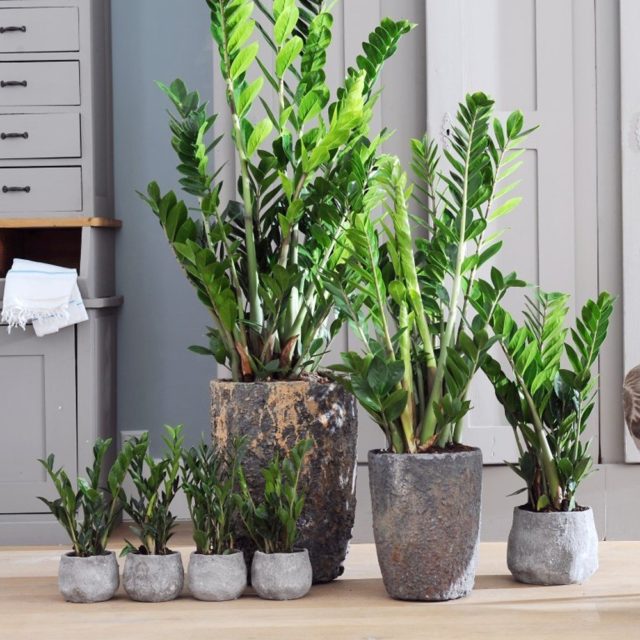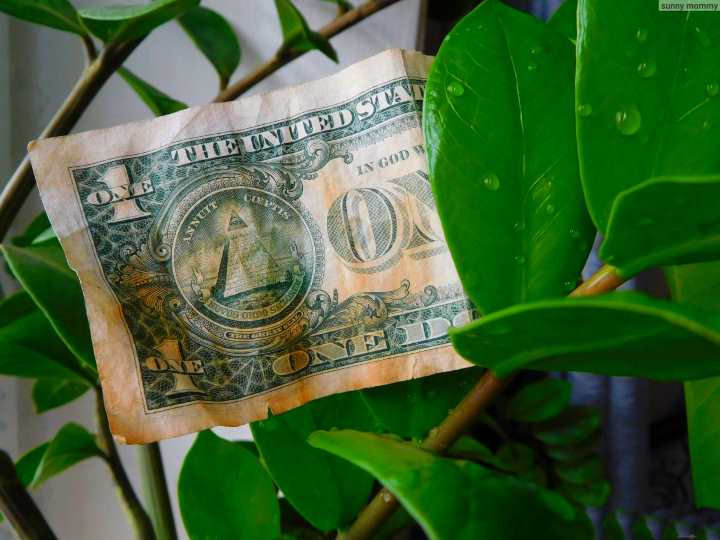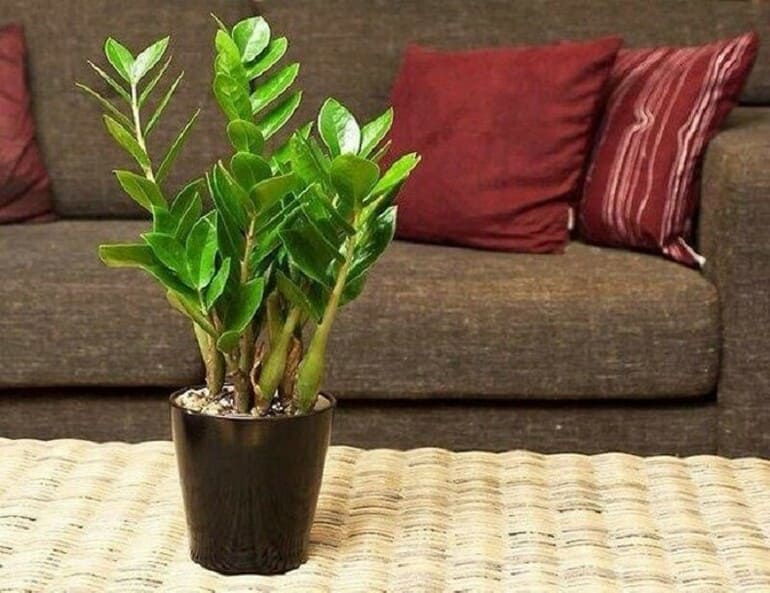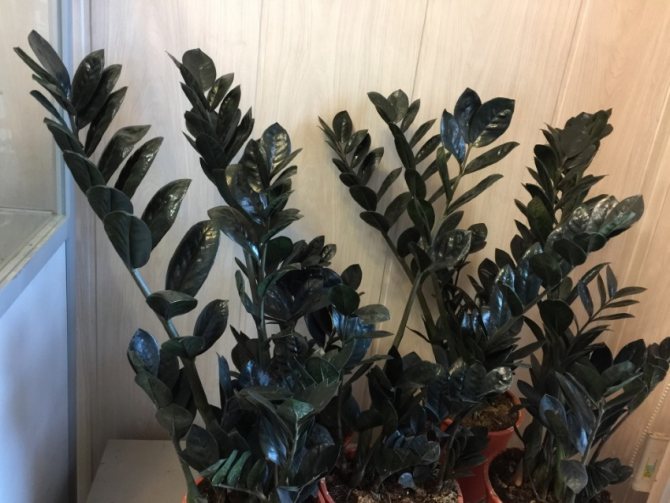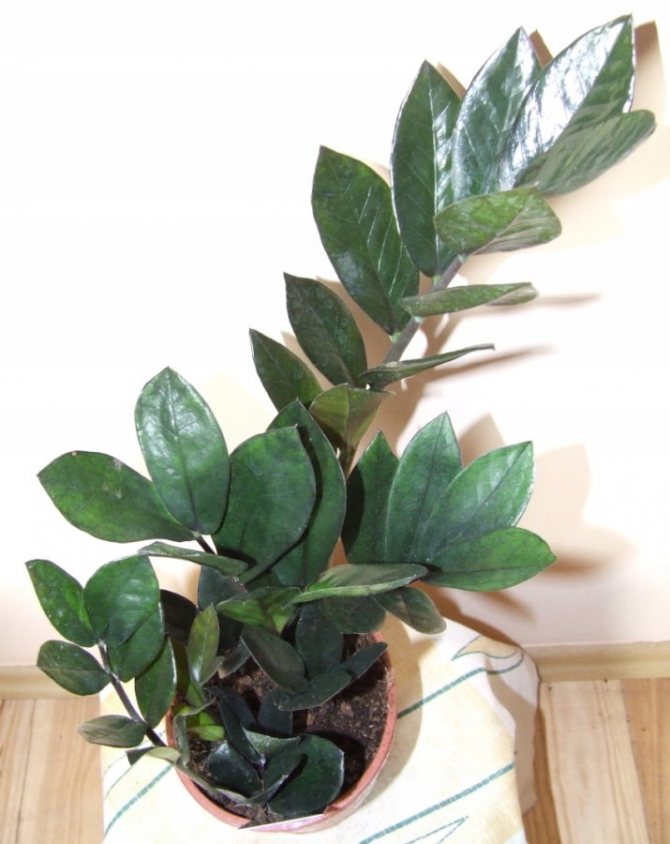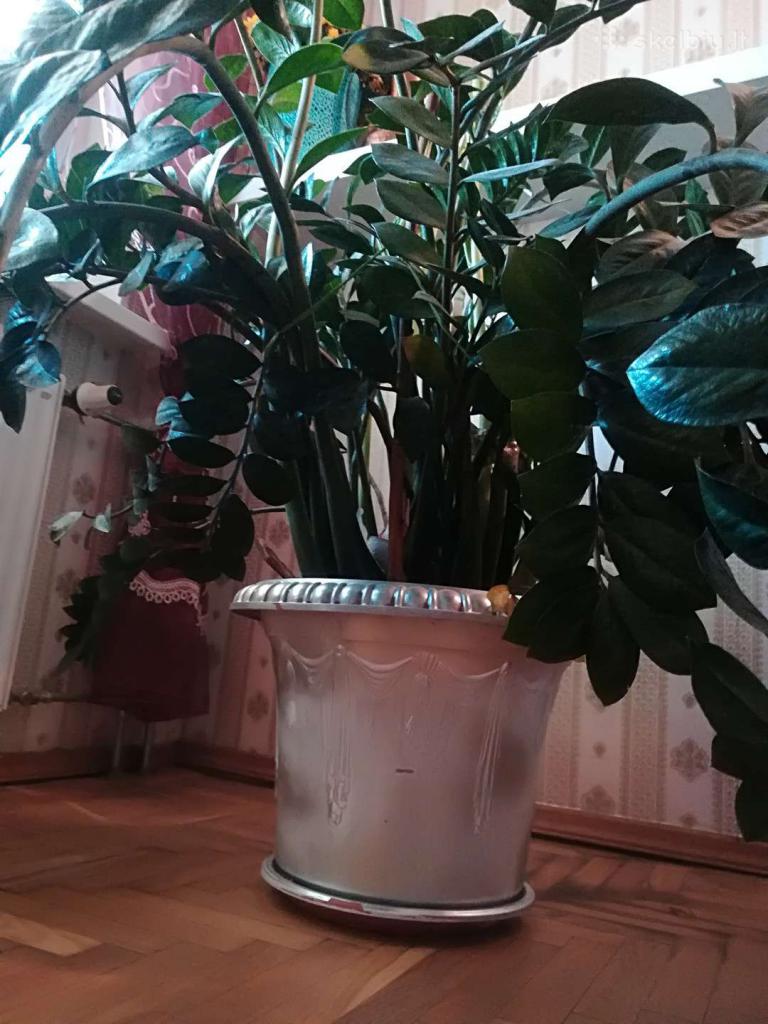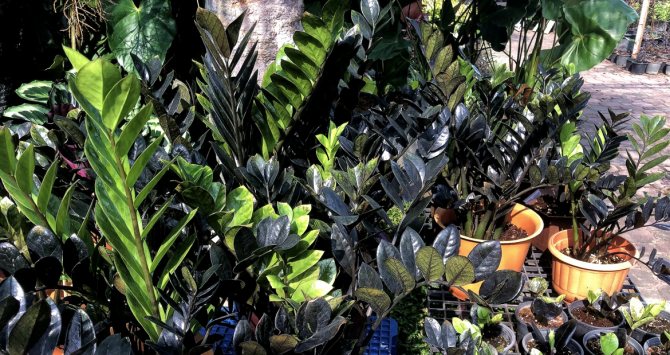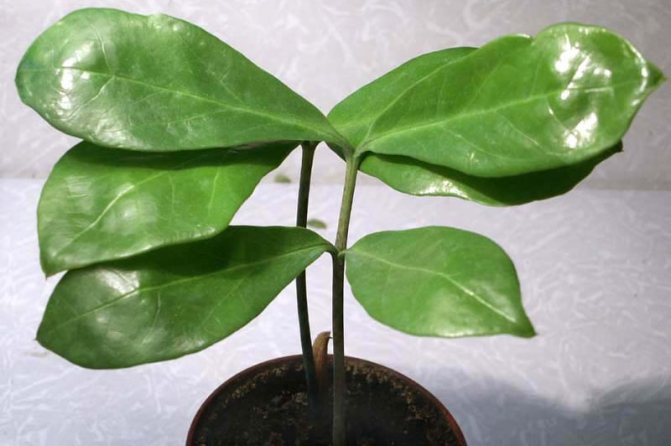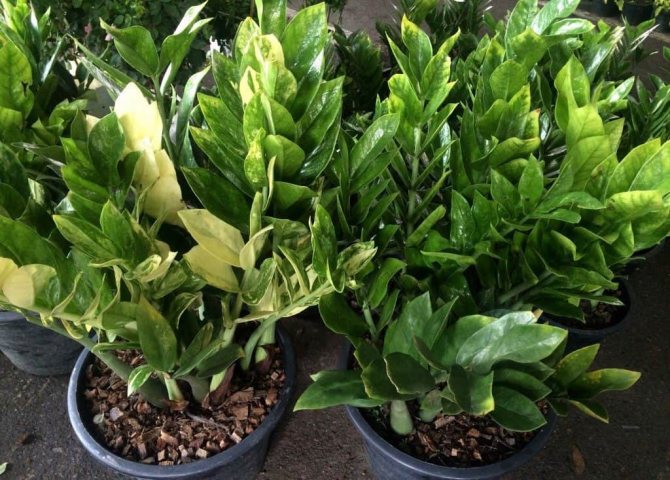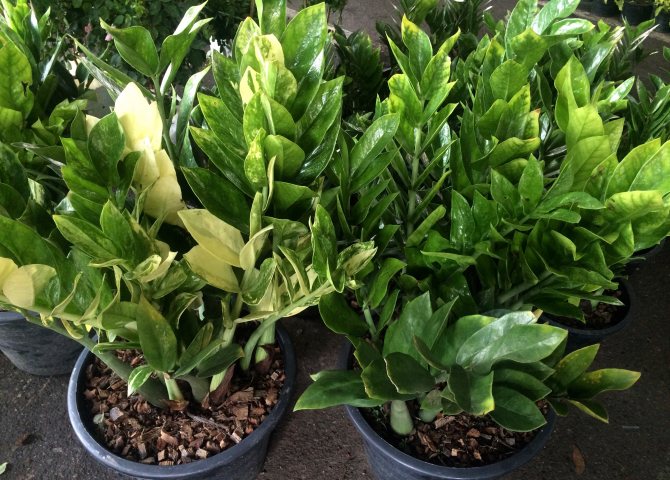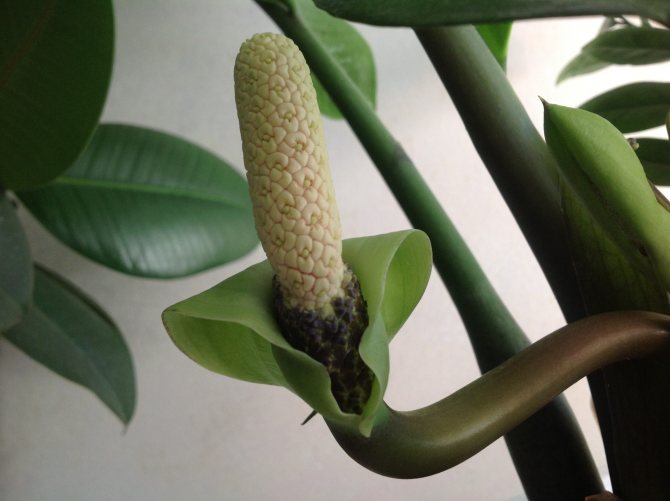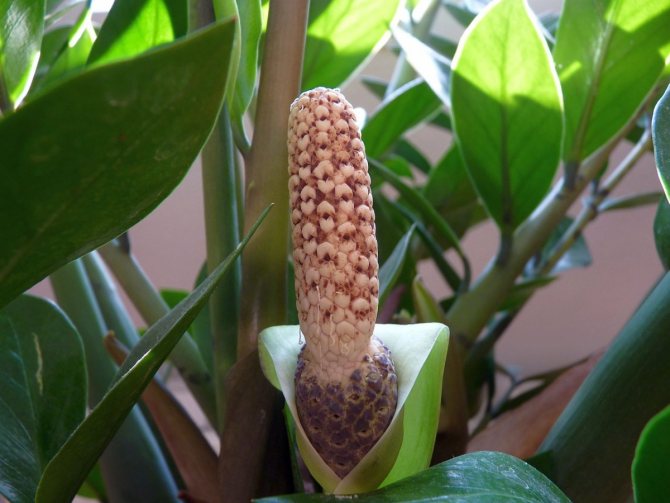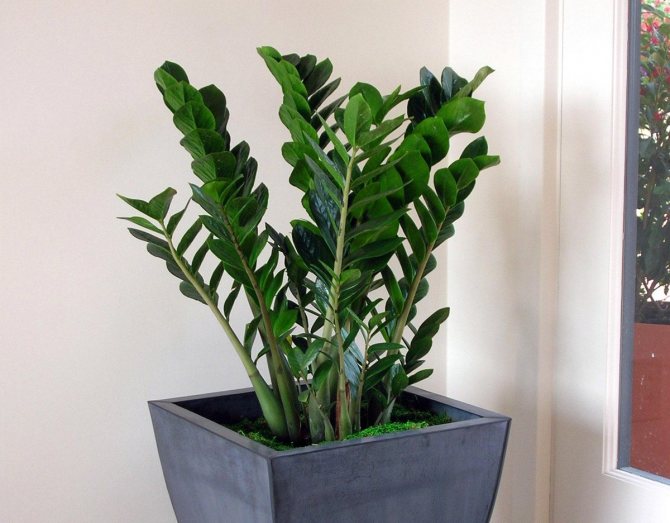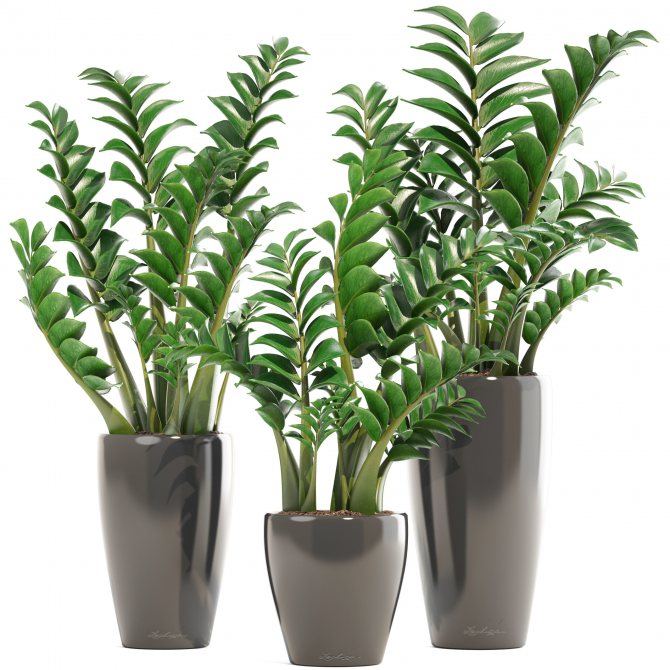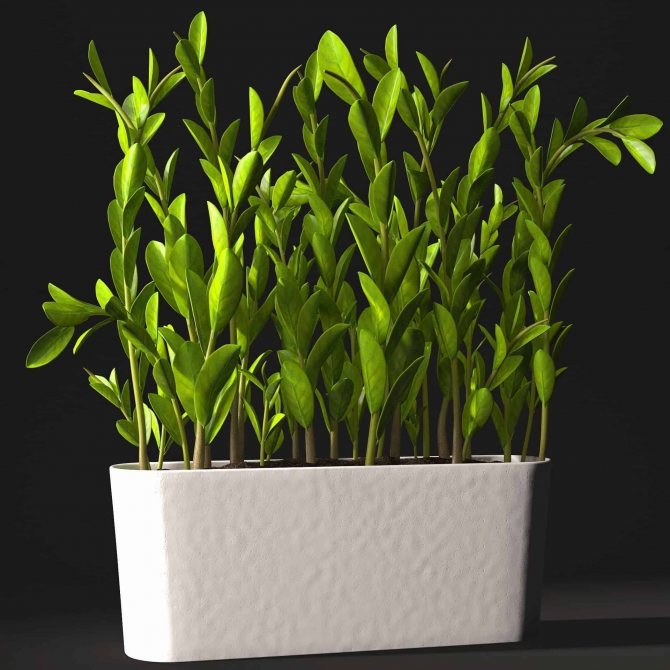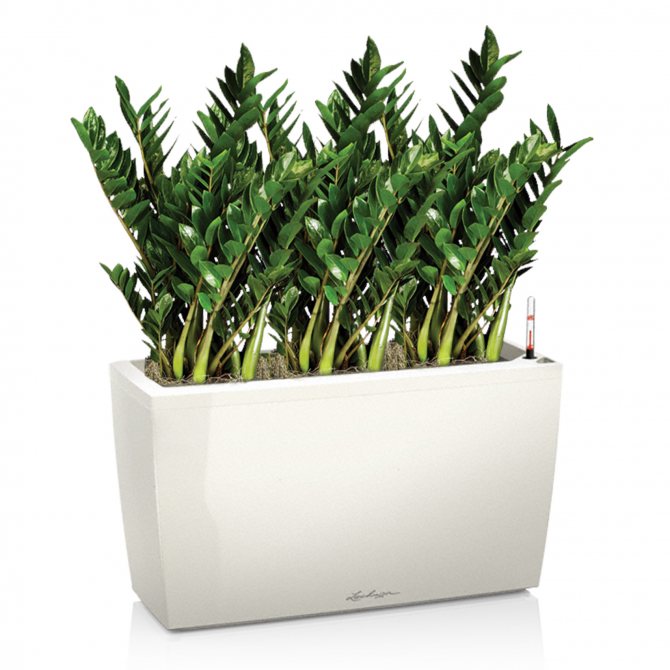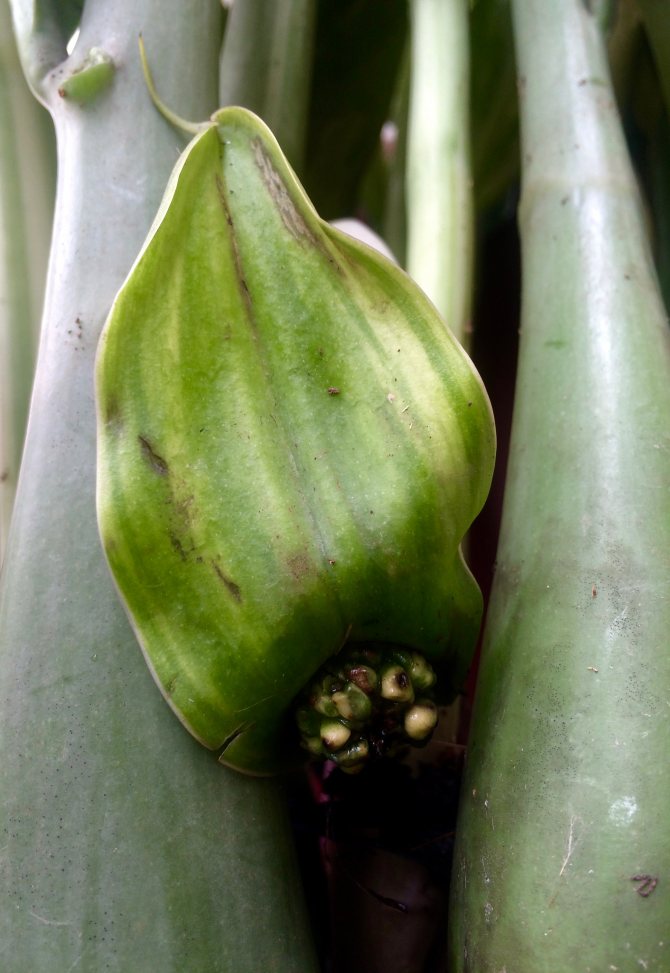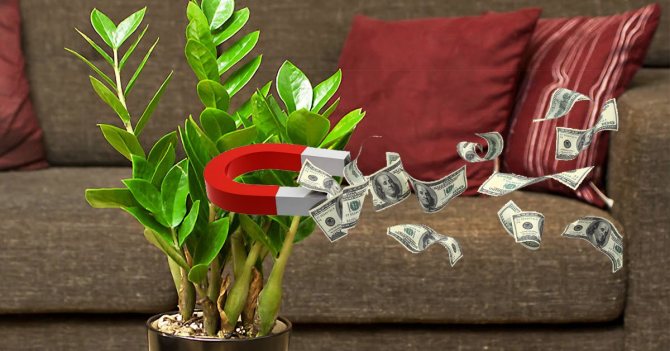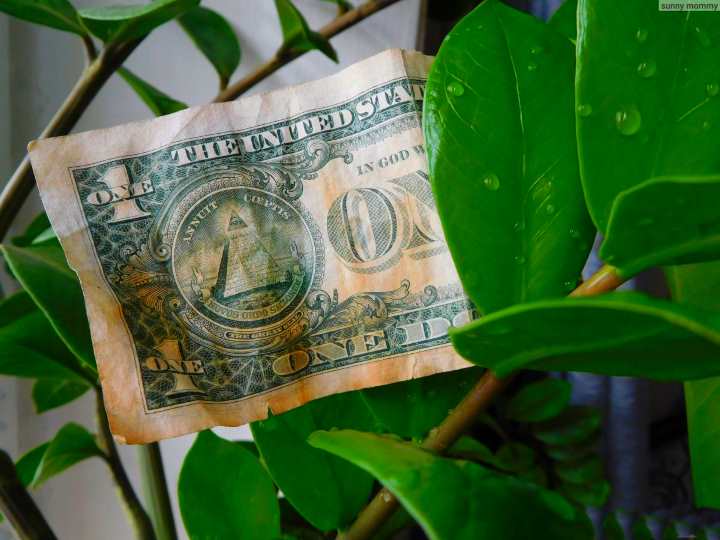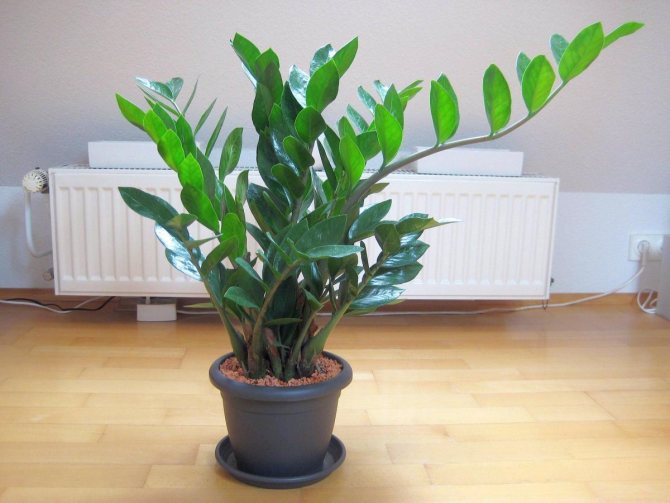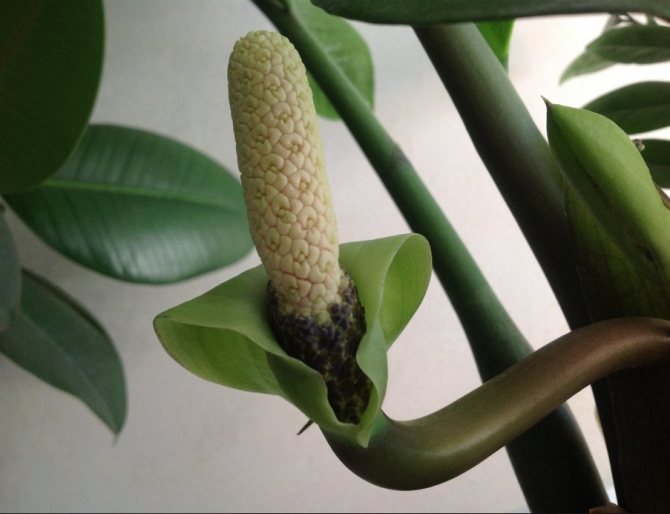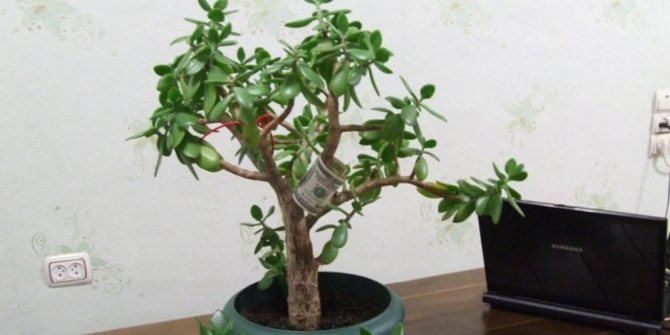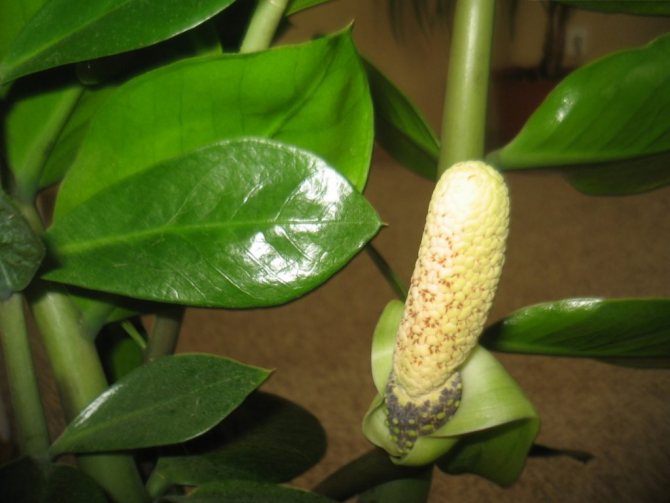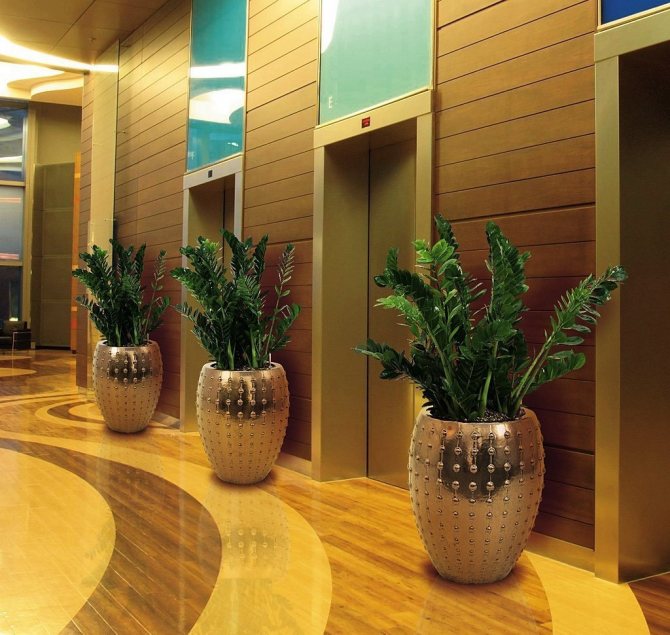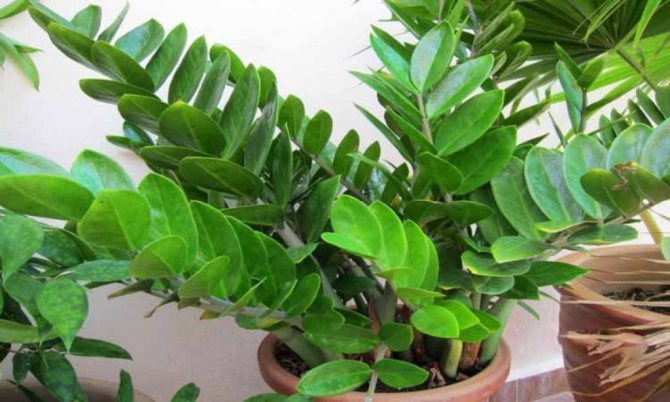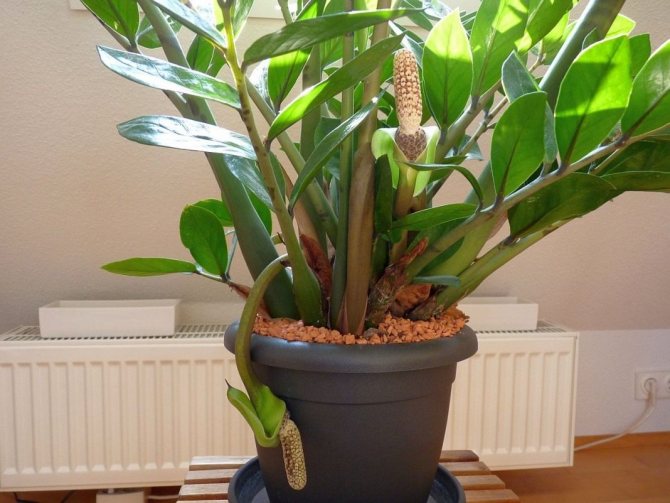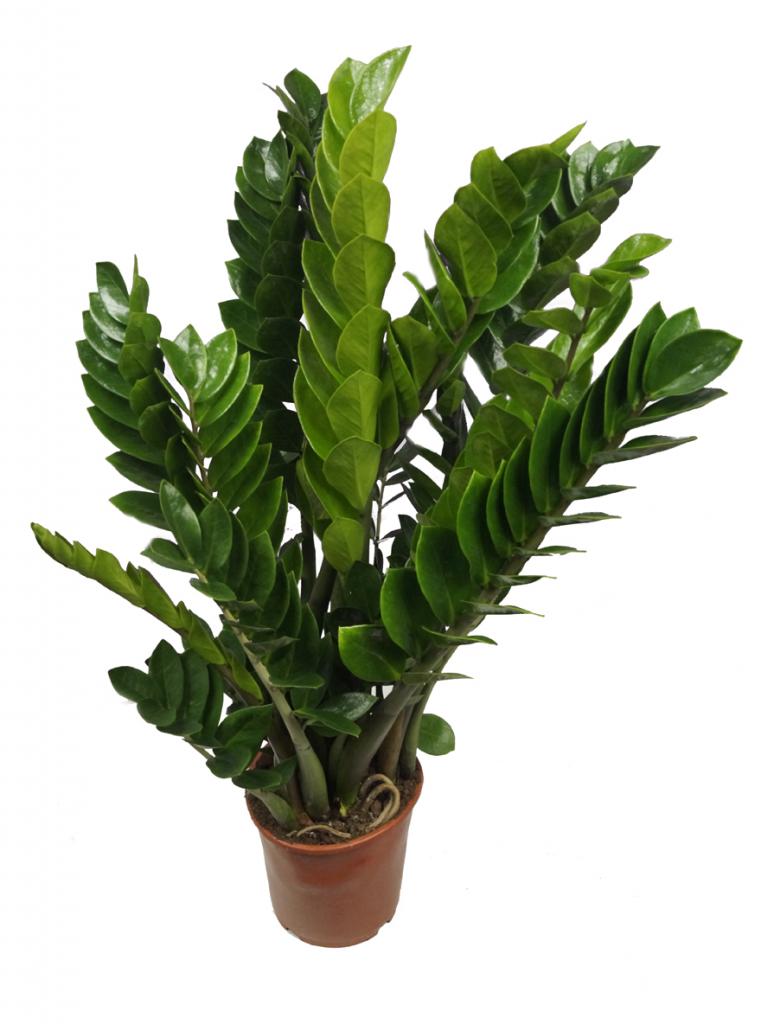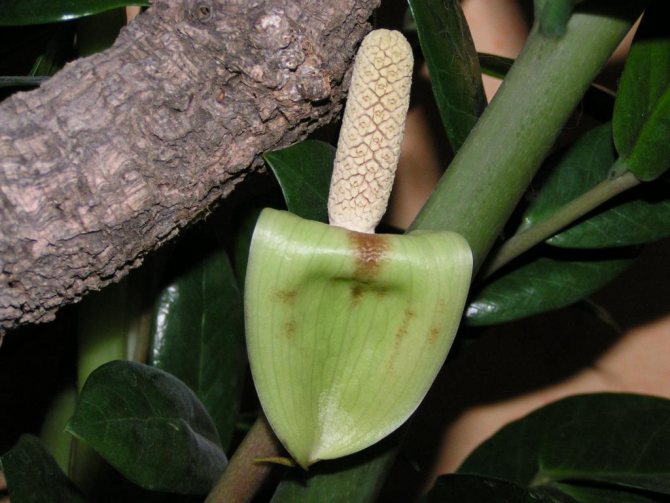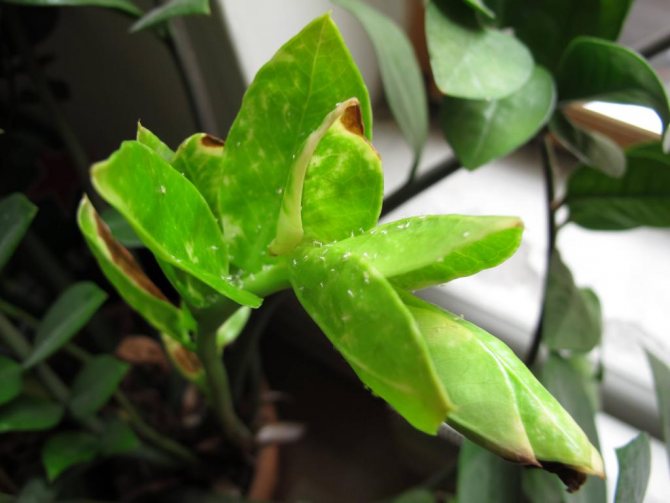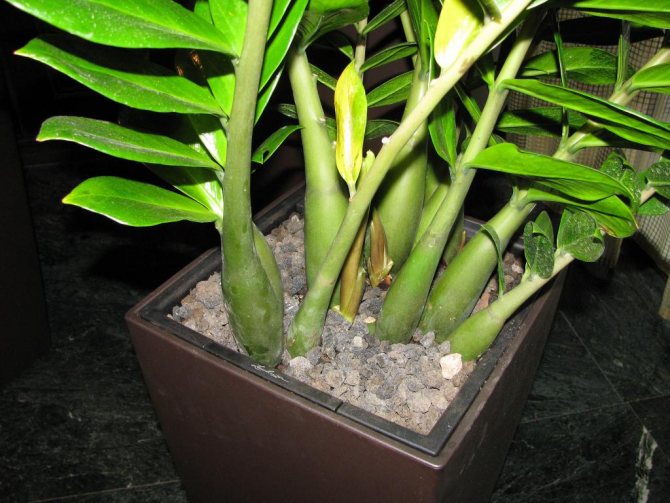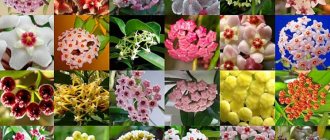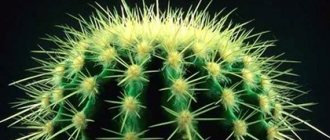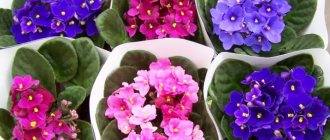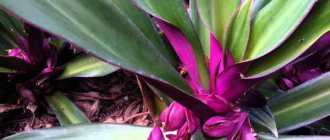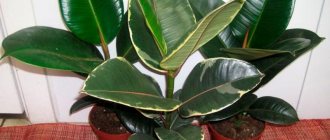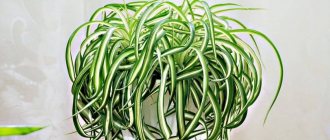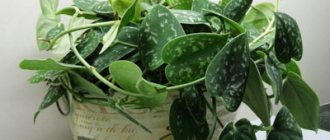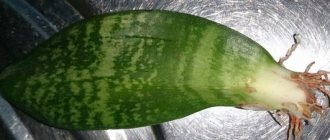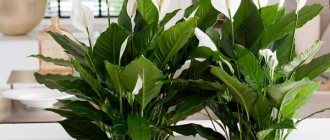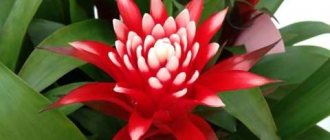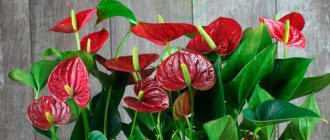Zamioculcas is an evergreen plant. Among the people involved in the reproduction of this type of flower, the culture is called the dollar tree, because, thanks to its powerful energy (as the representatives of Feng Shui say), it is able to attract material well-being and prosperity to its owner.
Scientifically, the flower is called Zamioculcas zamielistny because of its resemblance to zamia - a rare, gymnosperm plant. Culture at home does not require painstaking care. The flower is unusual in appearance. Its leaves stick out like feather sticks. They are often mistaken for trunks. The plant tuber, which accumulates moisture, is in the ground. Sometimes the flower grows up to a meter in length. The leaves, so close to each other, resemble a rosette.
The plant blooms unusually. In appearance, the flower looks inconspicuous and looks like a miniature corn wrapped in a petal. The flower appears almost at the base of the trunk. Zamiokulkas leaves have the correct shape. They are almost always the same size with a waxy coating that protects the plant from sunburn and moisture evaporation. It also gives the leaves a shiny look.
Botanical description
The very first descriptions of Zamioculcas date back to the beginning XIX century... However, the plant received an accurate and generally recognized classification only in 1828, when the famous British botanist Konrad Loddijes described the structure and shape of Zamioculcas in his writings. For the great similarity of the leaves of Zamioculcas with the already known at that time Zamia - a representative of the flora from the tropics of America - he was given the name Caladium Zamielistny.
In 1856, the name of the flower was changed to Zamioculcas Loddijes. And only in 1908 it was finally renamed as it is known today - Zamioculcas Zamielistny.
This plant is a succulent... The main reserves of water are stored in the root. It is tuberous with small processes.
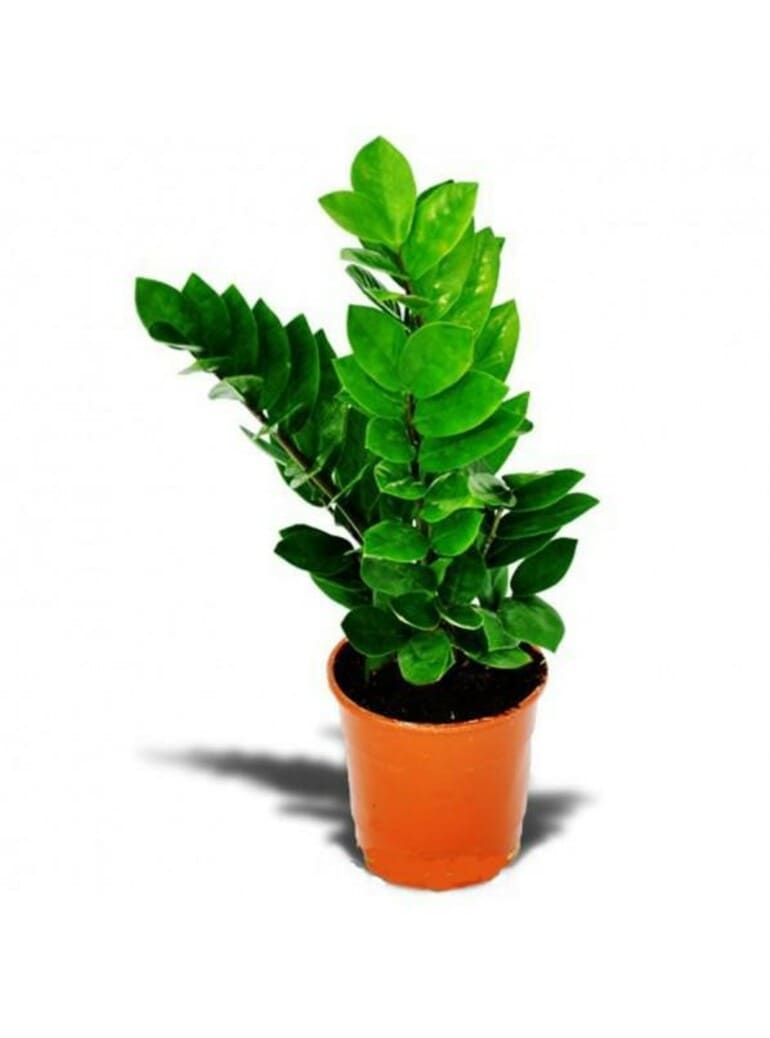
The plant develops thick, succulent evergreen leaves of the correct shape. In different varieties, they may differ in size: be small, but frequent, or, conversely, large, but rare. As a rule, they grow round in shape.
In height, the plant rarely reaches more than one and a half meters. Although in 2006 a decorative species was bred, which stops its growth, reaching only 40-50 cm in height.
The necessary conditions
Selection of soil and location
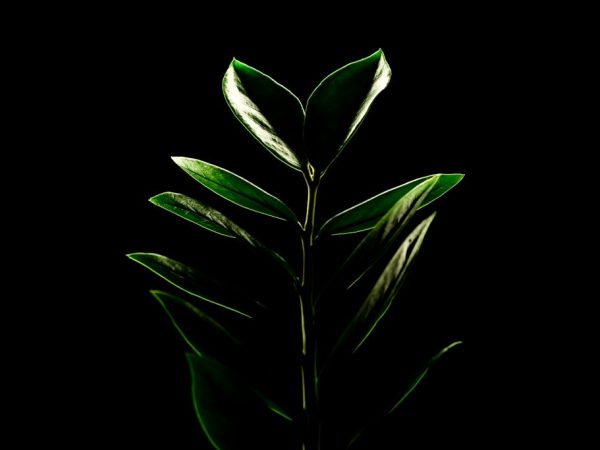

The flower should not be placed in direct sunlight
For planting, an ordinary universal soil mixture or a special one for succulents is suitable. You can also prepare the soil yourself from the earth, calcined sand and peat, mixed in equal parts.
It is also recommended to add a little crushed sphagnum or expanded clay - zamiokulkas loves loose and light substrates, where air can easily penetrate.
You can put the pot in any corner of the room, but it is important that the light is diffused. With age, the bush increases significantly in size, so it is most often placed in a tub on the floor.
Microclimate
| Humidity | Temperature | Lighting |
| The flower is not bad for dry air, but it reaches its maximum growth and beauty at relatively high humidity. In the summer heat and during the heating season, regular spraying will be required. | Optimal conditions are room temperature, not lower than 16⁰С. But the cold can provoke illness. The plant should be protected from drafts. | Zamioculcas is not picky about light and can even stand on the shady side and northern windowsills. But the plant has sensitive leaves, so they are shaded from direct sunlight, otherwise burns will form. Diffused light for at least 6 hours a day is the best solution. |
Plant structure
The most famous characteristic of Zamioculcas is its unpretentiousness. It is connected with the fact that the flower is ranked among succulents - that is, it has special tissues that store water in case of drought.
The bulk of the reserve moisture accumulates in the cuttings of the leaves, as well as in the root.
Roots
The roots of this flower are tuberous with small lateral and lower processes. It is in the tuber that most of the plant's water reserves are formed.
They have a bright yellow or pale gray hue and form faster than the aerial part of the flower. Zamioculcas seeks, first of all, to entangle the entire earthen lump in the pot in order to quickly take water and nutrients from the soil, and only then directs the surplus of the obtained micro and macroelements into the growth of green mass.
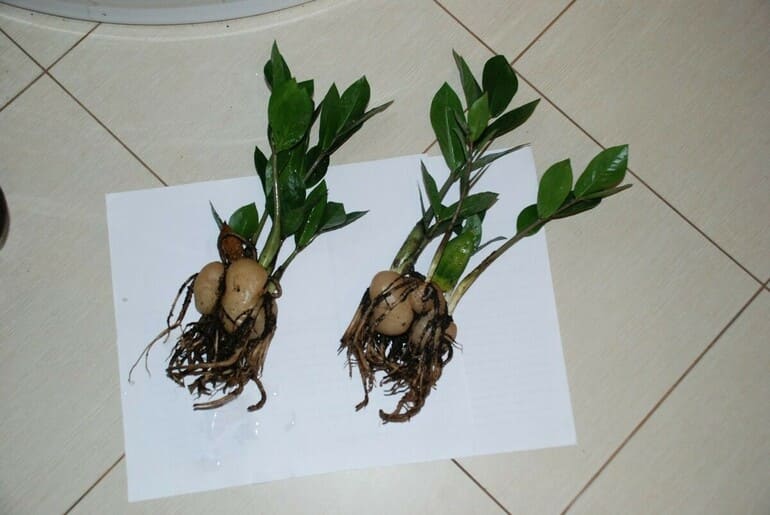

Leaves
Leaves are fleshy and dense. At their base, closer to the root, moisture is stored in case of drought. Cuttings of each small leaf are attached to a false stem portion that rises vertically upward from the root.
Interesting! In fact, Zamioculcas does not form stems at all. In fact, the leaves begin to grow from the very root. They just have such a complex structure that some may get the impression that their base is the stem.
The leaf blades are often formed quite small, which is why, in fact, the flower has become so widespread in decorative floriculture. They retain their green color throughout the life of the flower. Only occasionally can the leaves dry out and fall off, but this is due either to overdrying of the plant (for example, it spends too much time under the sun) or insufficient watering.
It is also worth remembering that the leaves of Zamioculcas need to be wiped more often, since their wax coating attracts dust. As an alternative method of cleaning a flower, some gardeners prefer water treatments - gently rinsing the plant under shower jets.
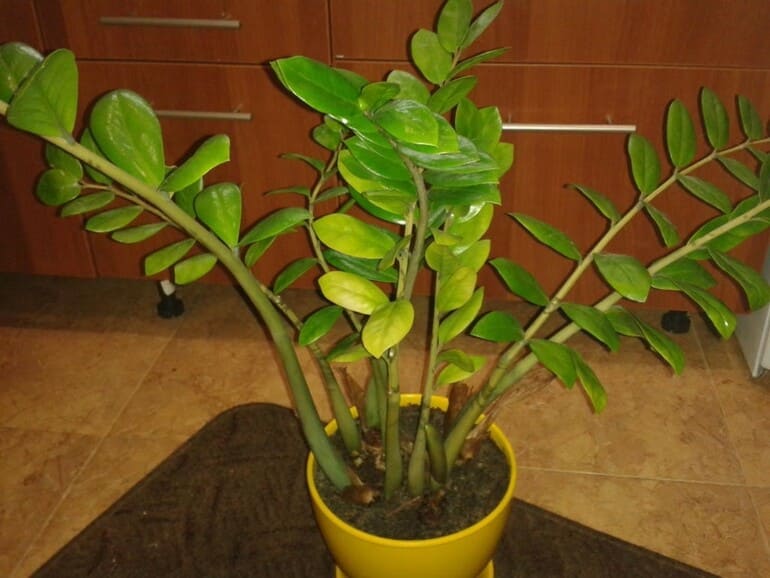

Zamioculcas is a succulent plant. But its juice is very poisonous. For this reason, you should only cut the leaves with rubber gloves, and after each even simple rubbing of the flower, be sure to wash your hands. Normally, the plant is not capable of causing harm, but as a precaution, children or pets should not be allowed to visit it.
Note! If the juice gets on the skin or mucous membranes, rinse the affected area immediately with warm water. If the juice gets into your mouth, then it is better to take a couple of activated charcoal tablets. In case of a particularly strong reaction to flower juice, it is recommended to see a doctor as soon as possible.
Flowers
It is extremely difficult to achieve flowering of Zamioculcas at home. To do this, you will have to achieve an almost ideal combination in terms of illumination, watering, fertilizing, transplants.
But the flowers themselves are quite discreet. They represent a small ear of dense white inflorescence, protected by a sheet of leaf.
Interesting! Due to the small attractiveness of Zamioculcas flowers, gardeners often immediately carefully cut off the formed flower so that it does not waste extra plant resources.
By the way, the shape of the flowers is very reminiscent of a human figure (the flower itself), dressed up in a dress (covering the leaf blade). Here there was a place for symbolism, because the people began to call the plant the flower of celibacy, believing that the woman-mistress of Zamioculcas would be able to marry only after flowering. Therefore, it is not customary to give it to unmarried ladies.
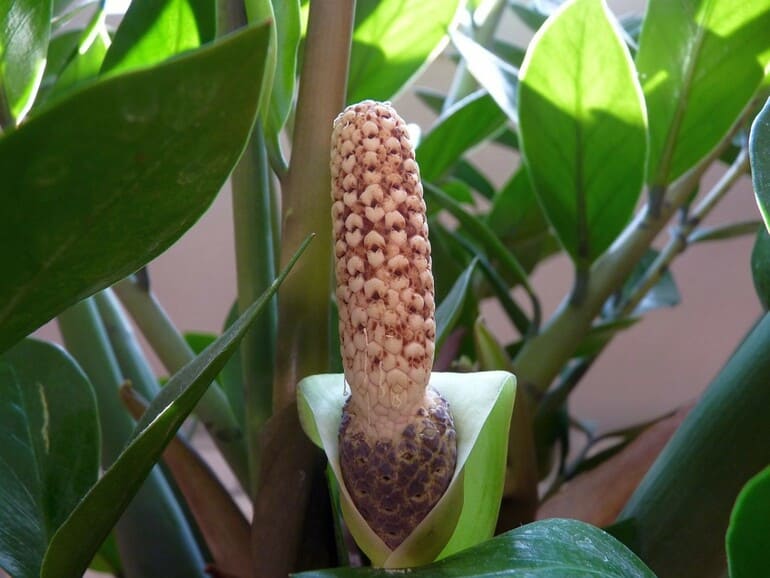

Fruit
It is difficult to achieve flowering from a money tree. Needless to say, the flower bears fruit at home even less often.
In nature, a single-seeded berry is formed from a flower. It is very similar in shape to a flower, but has a denser structure. By color, it is most often painted in a white or cream shade. But in some species, fruits are formed close to dark brown in color.
In indoor floriculture, almost no one succeeds in achieving ripening of seeds. And the seed reproduction method of Zamioculcas is rarely used. The fastest and easiest way to grow a new flower is from a cuttings or a detached leaf.
Diseases and pests
When caring for zamiokulkas, the most famous problem is yellowing of the leaves. There are 2 reasons: if old leaves turn yellow, it means that there is a replacement for young leaves; if new ones turn yellow, then the reason lies in waterlogging of the soil, leading to decay of the root system.
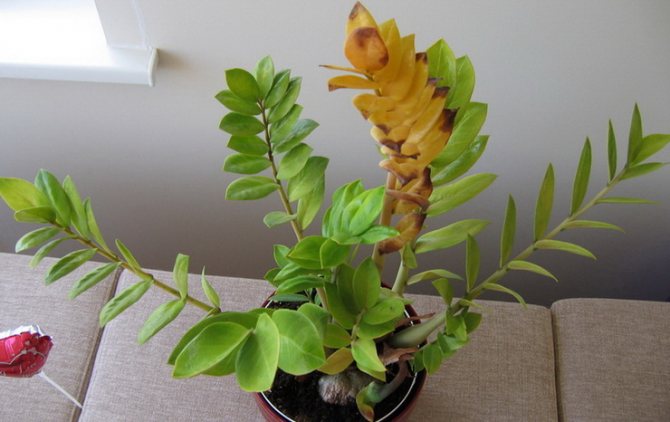

If the case is not started, then the flower can be brought back to life. To do this, the plant is taken out of the flowerpot, the earth is gently shaken off, and all damaged parts of the root are cut off. The cuts are treated with charcoal, and the whole culture is sprayed with Fundazol. After such manipulations, the dollar tree is again sent to the pot with new soil.
During drought, the leaves of zamiokulkas also fall off, but as the root develops further, new leaves appear when watering is resumed.
Ill-wishers rarely start on the flower. Most likely, they don't like its massive rind. If the leaves began to curl, it means that aphids have appeared. The pest is destroyed by any means of parasites, after washing the affected leaves with a moistened sponge. If brown spots appear on the leaves, it means that the plant is kept at a low temperature, perhaps you overdid it with watering or slipped through the flower.
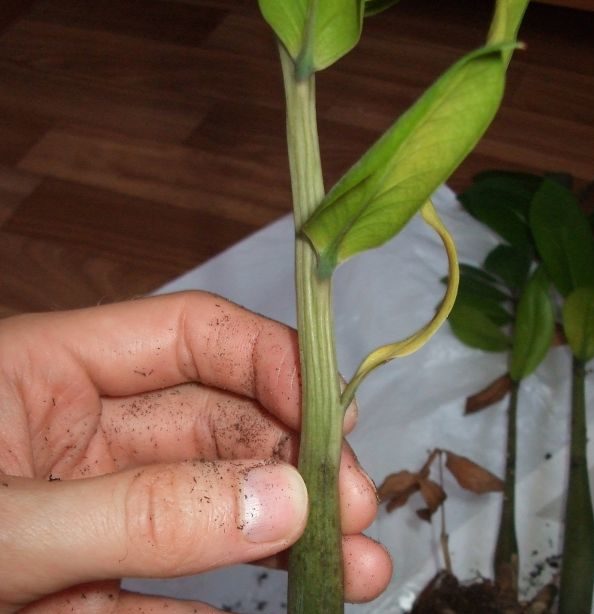

Dark spots with stripes on the stem are normal flower conditions, if at the same time the parts of the plant are not soft, which will indicate the appearance of rot.
Homeland of Zamioculkas
In the wild, Zamioculcas grows only in East Africa. The largest number of different varieties is recorded on the island of Madagascar.
The plant is most often found in the shade, although it can tolerate even severe drought. Some shrubs can be found in the open sun. Although the greatest species diversity is observed in the African steppes rich in herbal diversity.
Despite the tropical climate of its homeland, Zamioculcas is widespread in indoor floriculture, even in the northern regions of the planet. Basically, this was due to the unpretentiousness of the flower, its ability to endure even extremely unfavorable conditions.


Today Zamioculcas is very often an integral part of the decoration of modern interiors. It is prized for its exotic appearance, the evergreen nature of the leaves, and the dense, solid structure of the foliage that covers it.
The plant gained the greatest distribution after it began to be presented at numerous exhibitions, starting from the end of the 20th century. Moreover, such exhibitions concerned not only floriculture, but also all kinds of interior solutions.
Transfer
Echeveria - species: agave, Pulidonis, Black Prince, Purpuzorum, Lilacina
It is better to replant the dollar tree in spring. But if the flower was bought in a different season, it is better to deviate from the rule. The commercial shipping soil does not contain substances that are necessary for the healthy development of the plant.
On a note! You can not transplant the newly acquired Zamioculcas Raven. For 2 weeks, the plant should be placed in a room with no other flowers.
Low wide pots with many drainage holes are suitable for the Black Crow. The diameter of the container should be no more than 5 cm wider than the root system of the plant.
The procedure for transplanting a plant:
- Drainage and a small amount of soil are poured into a new pot.
- The flower is carefully removed from the old container (the plastic pot can be cut) and transferred to a new one.
- The nutrient mixture is poured into the empty space and compacted a little.
- Part of the rhizome is left above the soil surface.
For sick specimens, this method is not suitable. You will have to completely clear the roots from the soil, rinse and cut off the damaged areas. The same should be done when dividing large plants.
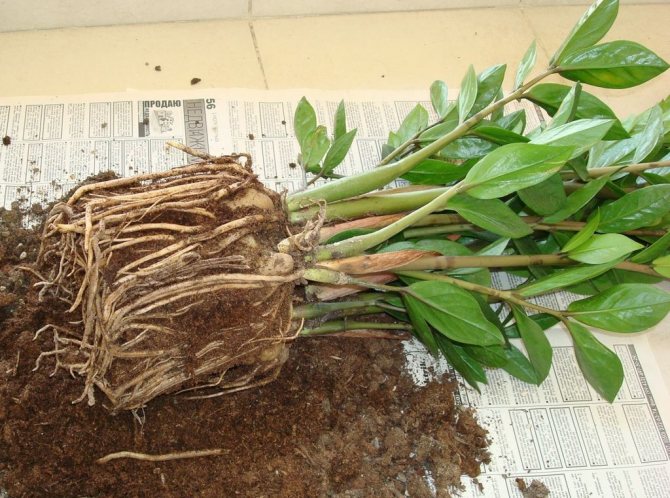

Zamiokulkas has very sensitive roots
Due to the increased sensitivity of the roots of the flower, its transplant is carried out by the transshipment method while preserving the earthen coma. After that, it is better to put the plant in a shaded warm room, and after rooting, move it to a permanent place.
Interesting Facts
- The dollar tree is not the only popular nickname for Zamioculcas. It is also called the Tree of Fortune, although many luck and money are quite close concepts to each other.
- But the plant has not the most pleasant fame. It is popularly known as the flower of celibacy. It is believed that it attracts envious people and ill-wishers, so women are often afraid to keep Zamioculcas at home. On the other hand, it is believed that after the flower blooms, all adversity is "thrown off." However, the trouble is that it is difficult to achieve flowering of this plant, and it occurs late, already at the end of the life of Zamioculcas.
- It is because of this unpleasant omen that if you want to present Zamioculcas as a gift, then it is customary to do this exclusively for men or married women.
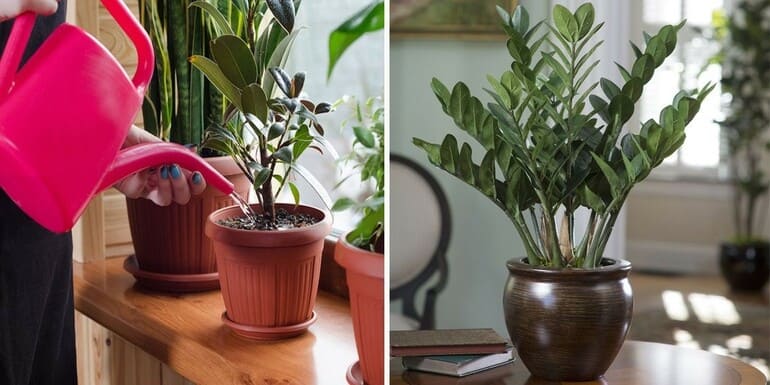

Folk beliefs associated with the "dollar tree"
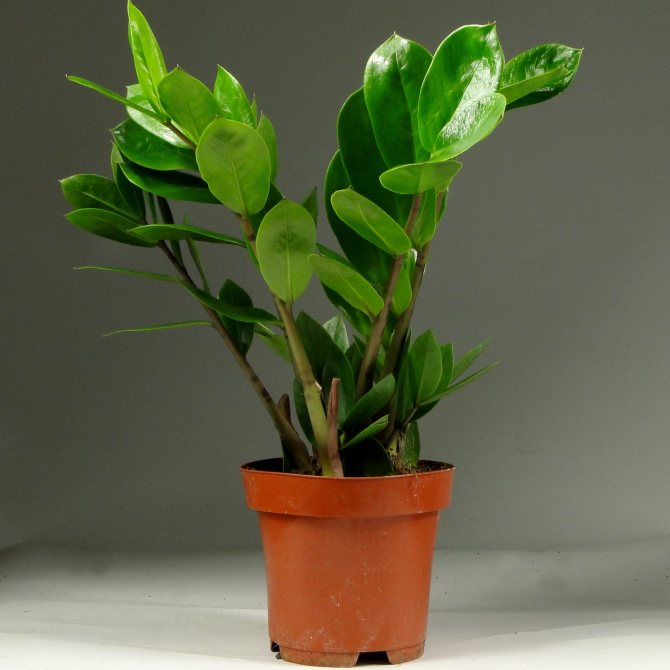

- If you decide to settle zamiokulkas in your house, then in the near future you will see an improvement in your financial situation. The flower is able to attract money to the house. Bury coins, preferably foreign currency, or rolled dollar bills into the ground.
- If you accept this plant as a gift, you should give a few coins in return. This will pay off the negative energy that the dollar tree carries into the house.
- To be successful in business requires proper plant care. Falling and yellowed leaves are a bad omen, which indicates an imminent deterioration in the material condition.
- If the plant does not take root well in the house, then the household has false goals in life.
- For the dollar tree to work effectively, talk to it like a human being. Water him as the earth dries up and at this time have affectionate conversations with him. Ask for wealth and prosperity. Make requests for help with the growing moon on Tuesdays.
- There is a belief that a flower needs money water. Pour a small amount of cold liquid into the coin and let it brew for two days. Water the tree with this water. Do not remove the coins from the container until the water runs out.
- If the plant has withered, this is considered a bad omen. You can't throw it away. Either cure it or buy the same flower. A healthy plant will share its energy with a diseased tree.
- A flower presented for New Year, Christmas, housewarming or birthday has a hundredfold energy to attract wealth and good luck.
Flower varieties
In the wild, only one species of Zamioculcas, called Zamioculcas Zamielistny, grows in the wild.
The plant gained popularity in indoor breeding at the end of the 20th century. People were attracted by the unusual shape of the leaves and the relative unpretentiousness of the flower. Today, several plant varieties are most widespread, which are preferred for growing in homes, offices, and public spaces.
- Zamioculcas Lanceolate (Lanceolata), the main feature of which is considered to be pronounced leaves with large plates in width and length.
- Zamioculcas Variegated (Variegata). This is a rather rare variety, the main characteristic feature of which is the variegated color of the leaves pointed at the edges. The variety grows up to 1-1.5 meters in height.
Also, for a long time, the variety Zamioculkas Buevena (Buevena) was isolated, which was later attributed to another genus of plants.
Superstition second
Zamiocukals is considered a flower that brings happiness to a woman. A prerequisite for achieving female happiness is to present it. In addition, several yellow or gold coins must be paid for it. Such a flower has magical powers and if it blooms, then you can prepare for the wedding.
The flowering of the plant as a signal is not limited only to the expectation of the groom.
This could be:
- The appearance of a new family member;
- Promotion or salary increase;
- An unexpected legacy;
- Expensive gift;
- Moving to a new home;
- For a young married couple, this may mean that a child is soon to be born.
Even in the absence of flowering, the healthy appearance of the plant, the bright color and density of the leaves signals the well-being of all family members and, above all, women in the near future.
You cannot sell sprouts from a plant, you can only give them, receiving a ransom in several coins. It is especially impossible to do this on wedding days, your husband's and your own birthday, and on the days of the most significant events, otherwise the happiness of the family will go away. It is categorically impossible to accept and give zamioculcas on children's birthdays.
It is considered a bad omen if, for no apparent reason, the zamioculcas wilted.
It is necessary that you be presented with a young plant that will give strength to the withering one.


Plant care
It is possible to cope with the cultivation of Zamioculcas at home without many years of experience behind you and some special skills, training. The thing is that, despite its homeland in the tropics, the flower quite steadfastly tolerates even serious adverse factors. For example, he is not at all afraid of drafts, not even too whimsical in terms of watering. However, it is worth knowing some of the subtleties of care. Otherwise, the plant will not please with a healthy look and is unlikely to be able to live for a long time.
Interesting! Zamioculcas grow on average for 5-10 years. The better the care, the longer the lifespan.
Find out more about caring for zamiokulkas at home.
Watering
Although Zamioculcas has a tuberous root that can accumulate a lot of moisture, you need to water the flower regularly.
In the summer, you should wait for the top of the soil to dry. If we follow these indicators, then the approximate and optimal frequency of soil moistening in the warm season is no more than 2 times a week. Some gardeners prefer to water Zamioculcas just once a week.
In winter, watering is expected to be reduced. It is believed that one watering will be enough for Zamioculcas in 2 or 3 weeks.
note! If the flower is watered incorrectly, then it begins to shed its foliage. Moreover, both with insufficient watering, and excessive watering.
Reproduction of the black dollar tree
Zamioculcas Black can be propagated by dividing the bush, cuttings or leaves.
Zamioculcas - home care
The baby is a separate sprout, it is easier to root it in new soil.To separate part of the bush, the tree is taken out of the pot and the earth is removed. Divide the rhizome with a sharp knife and leave the roots to dry in the fresh air for several hours. The separated fragment is planted in the prepared soil. At first, watering the seedling should be minimal.
Cuttings and leaves are initially left in clean water without germination. After the roots appear, the seedling is placed in prepared soil and left in a shaded place. To prevent rotting of tubers, charcoal is added to the ground. The process of formation of the root part in zamiokulkas takes a long time, up to several years.
Note! Until a root system sufficient for vegetation is formed, the flower is in no hurry to release stems.
Output
Easy to care for, noble in appearance, slowly and correctly growing Zamioculcas today is not by chance experiencing a real peak of popularity. It really fits well with modern interior styles, which is why it has become widely used in the design of apartments, houses, offices, etc.
But the main feature lies in the fact that Zamioculcas is famous for its unpretentiousness, the ability to sink a large amount of moisture at the root. This means that there is no need to follow closely and sensitively.
In addition, among people there are signs associated with Zamioculcas or otherwise - the Dollar tree. Since this flower is believed to bring financial well-being, this is another obvious feature for which it can increasingly be found in the collections of gardeners.
Methods for reproduction of zamiokulkas at home
Like other cultivated plants, the dollar tree propagates by tuber and cuttings. Read more about each method below.
Propagation by cuttings
To do this, you need to select any part or leaf of the plant and plant it in wet, sterile soil. The cut is treated with a preparation accelerating rooting. Next, a greenhouse condition is created for the future flower of the zamioculcas, and the stalk itself is sent to a warm, well-lit place. The cut takes root from a month to six months. If necessary, the ground is moistened, and the cutting is aired.
Tuber propagation
In this way, only adult crops with a massive root are bred. The tuber is cut so that there is one growth point on each part.
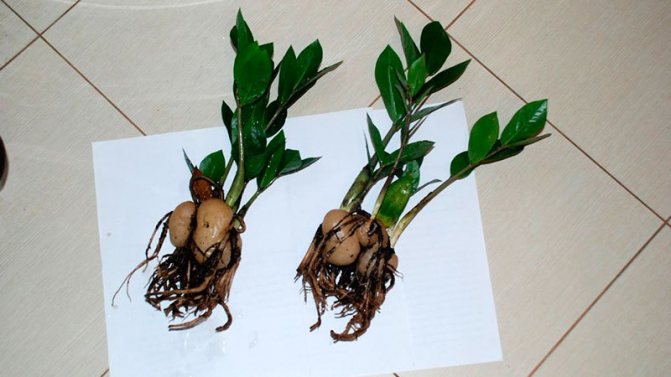

The tuber is planted in a previously prepared soil, practically without burying it. The new plant will take a very long time to grow.
Why doesn't zamioculcas bloom?
The reasons, as a rule, are in improper care. Plant age plays a role, but not of primary importance. If an adult zamiokulkas does not create favorable conditions for flowering, then it will not work to see it in all its glory.
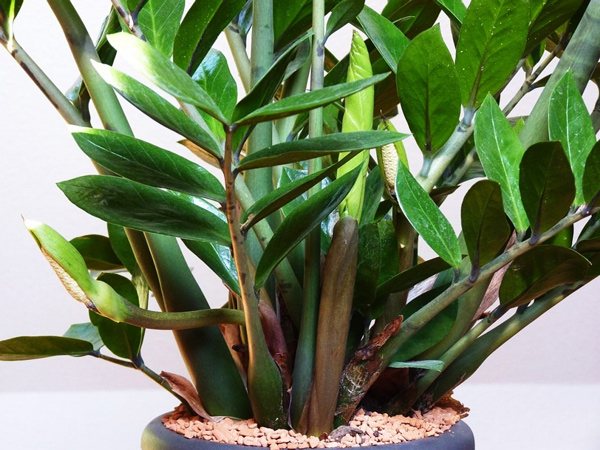

It is also important not to overdo it with expressions of concern. Frequent watering and an abundance of sun, heat will not accelerate growth, but will provoke rotting of the root system and burns of the leaves. An excess of fertilizers is as destructive as a lack of them, so everything should be in moderation.
You should not choose large pots, the soil is enough for 2 - 3 cm more than the volume of its own roots.
Succulents resist diseases well, but it will not be superfluous to periodically inspect the leaves and soil for the presence of parasites.


